
BY ALAN M. PETRILLO
The Federal Aviation Administration (FAA) designates airports as Index A through E and aircraft rescue and firefighting (ARFF) vehicles as Class 1 through 5.
Class 1 through 3 ARFF vehicles are smaller rigs carrying a mix of water, foam, and dry chemical or halogenated agent that protect small to midsize airports, and the kinds of equipment they carry in many cases mirror those of larger Class 4 and Class 5 ARFF rigs.
FAA REQUIREMENTS
For example, an Index A airport handles planes such as the Gulfstream 3, Lear 55, Beech King Aire 200, and DeHavilland Dash 8, among others, while an Index B airport takes all those aircraft and adds Airbus A-320 300, Boeing 737-300, and Embraer 170/175 and 190. An Index C airport then adds Boeing 727-200, Boeing 757-800, MD 88, and Bombardier CRJ1000. Index D airports add Airbus A-300 through 350-800 and Boeing 767-300 and 787-8, and Index E airports can handle Airbus A340 through A380Antonov AN-225 and Boeing 747 and 787-9 aircraft.
The FAA also determines the minimum levels of firefighting agents by type and quantity on an ARFF vehicle to support a specific airport index. Class 1 vehicle requirements are 100 gallons of water/aqueous film-forming foam (AFFF) and 500 pounds of dry chemical (sodium or 450 potassium based) or 460 pounds of halogenated agent; a Class 2 ARFF rig must carry 300 gallons of water/AFFF and 500 pounds of dry chemical or 460 pounds of halogenated agent; Class 3 ARFF vehicle requirements are 500 gallons of water/AFFF and 500 pounds of dry chemical or 460 pounds of halogenated agent; Class 4 ARFF rigs must carry 1,500 gallons of water/AFFF; and Class 5 ARFF trucks are required to carry 3,000 to 4,000 gallons of water/AFFF.
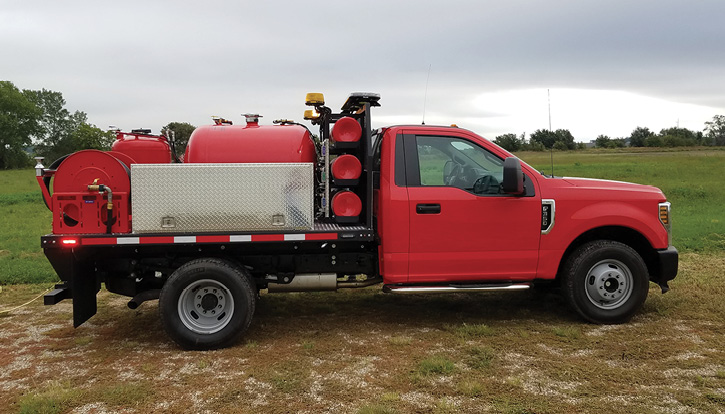
1 Unruh Fire built this small ARFF rig for the Liberal (KS) Fire Department, which covers a local airport, on a Ford F-350 chassis and nine-foot custom-built flatbed carrying 500 pounds of dry chemical, a TRI-MAX TM5200 CAFS unit with 200 gallons of premix, and a twin-agent hose reel. (Photos 1-3 courtesy of Unruh Fire.)
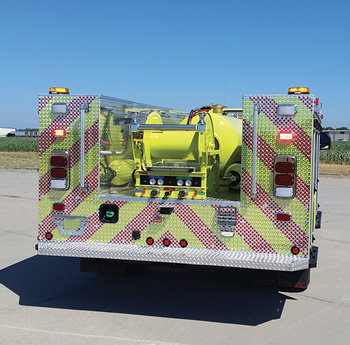
2 McCarran Airport (NV) had Unruh Fire build a small ARFF vehicle on a Ford F-550 chassis with a custom-built low-profile 11-foot aluminum body, carrying a TRI-MAX TM5300 CAFS unit and 300 gallons of premix.
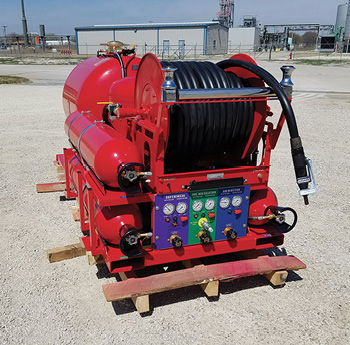
3 This small ARFF skid unit built by Unruh Fire for the Las Cruces (NM) Fire Department has a TRI-MAX T5200 CAFS unit, 200 gallons of premix solution, and a twin-agent hose reel.
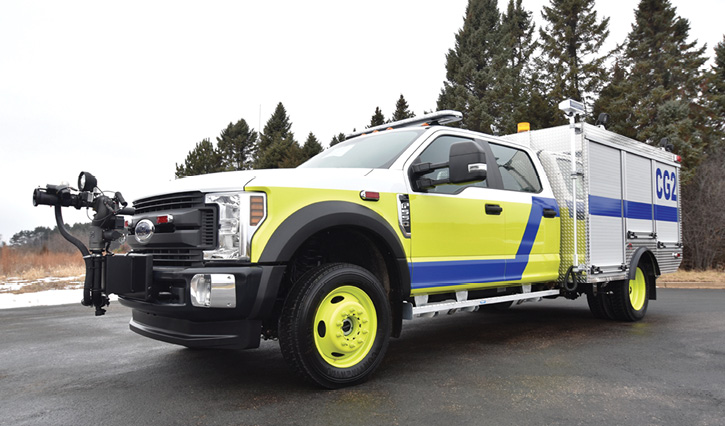
4 Rosenbauer built this Airwolf C2 small ARFF truck for the U.S. Coast Guard at Port Angeles (WA) on a Ford F-550 chassis and four-door cab with a Darley 2-1/2 AGE 300-gpm pump, 300 gallons of water, 40 gallons of foam, and a 500-pound dry chemical tank. (Photos 4-7 courtesy of Rosenbauer.)

5 This Airwolf C2 ARFF truck built by Rosenbauer for the Buffalo Niagara (NY) International Airport carries a CAFS unit and a Halotron extinguishing agent.

6 Cape Girardeau (MO) Regional Airport had Rosenbauer build its Airwolf C3 ARFF truck on an International Navistar HV507 chassis with a 2-1/2 AGE Darley 300-gpm pump, 500 gallons of water, 60 gallons of foam, and a 500-pound dry chemical tank.
UNRUH FIRE
Wes Schamle, sales manager for Unruh Fire, says Class 1, 2, and 3 ARFF vehicles are what his company specializes in. “They are in two styles of truck,” Schamle says, “one carrying a propelled agent in pressurized containers where there’s a nitrogen cylinder, a premix container, and a dry chemical container. The other style truck is a pump drive with an engine-driven pump, usually carrying foam and sometimes having a compressed air foam system (CAFS).”
Schamle notes that the bigger index airports usually have larger ARFF trucks (Class 4 and 5 trucks), although some of the Index A, B, and C airports might also have a larger ARFF rig along with their smaller versions. “A lot of airports across all indices are using smaller ARFF trucks to cover their parking garages because of the low height clearance issues,” he says. “A lot of them choose the smaller style vehicle with a propellant-driven agent onboard.”
The combined-agent pump-driven ARFF truck that Unruh typically builds is on a Ford F-550 Super Duty Crew Cab XL 4×4 chassis with an aluminum rescue body and a 6.7-liter Powerstroke V-8 diesel engine, Schamle says, with a Darley 2-1/2 AGE pump powered by a 44-horsepower (hp) Kubota diesel engine, dual crosslay preconnects in trays, a 300-gallon polypropylene water tank, a 40-gallon foam cell, a 500-pound dry chemical tank with dual 400-cubic-foot nitrogen bottles, a FoamPro foam transfer pump, a FoamPro AFFF injection foam system, a Hydro-Chem dual-agent handline and nozzle, a Hydro-Chem dual-agent bumper turret, and a Hannay dual-agent electric hose reel.
Unruh Fire also makes a stored CAFS rapid intervention vehicle (RIV) aircraft rescue truck on a Ford F-550 Super Duty Crew Cab 4×4 with a TRI-MAX TM-5300 high-energy cold compressed-air foam (HECCAF) firefighting skid of 100 or 300 gallons, 500-pound dry chemical tank, and dual-agent bumper turret. Unruh’s ARFF rescue skid units are custom made to order with either 100- or 300-gallon TRI-MAX HECCAF premixed foam tanks as well as 500 pounds of dry chemical twin-agent electric rewind hose reel, two dual-agent hoselines, and Hydro-Chem twin-agent nozzles.
ROSENBAUER
Tague Johnson, ARFF sales coordinator for Rosenbauer, says his company makes the Airwolf C2 and C3 models of ARFF trucks aimed at the smaller airport market. “The Airwolf C2 is on a Ford F-550 4×4 chassis with a two- or four-person cab, a Darley 2-1/2 AGE 300-gallon-per-minute (gpm) pump powered by a diesel Kubota engine, 300 gallons of water, 40 gallons of foam, and a 500-pound dry chemical system,” Johnson says. “The Airwolf C2 has a Rosenbauer/Elkhart Brass bumper turret with a 125-gpm standard setting, although it can be reset to a minimum of 60 gpm or a maximum of 600 gpm. The pump is in the left front compartment, all the controls are in the cab, and the truck has a twin-agent reel that can flow either water/foam or dry chemical agent.”
Rosenbauer also makes the Airwolf C3 on an International Navistar HV507 (the former 7400) 4×4 chassis in both two- and four-door models with a Darley 2-1/2 AGE 300-gpm pump powered by a diesel Kubota engine, 500 gallons of water, 60 gallons of foam, and a 500-pound dry chemical system with an option for a Halotron system. “The Airwolf C3 has the same bumper turret and twin-agent reel as the Airwolf C2 model,” Johnson points out, “but is on a beefier chassis that has a gross vehicle weight rating of up to 40,000 pounds, usually on a 13,000-pound front axle and a 24,000-pound rear axle.”
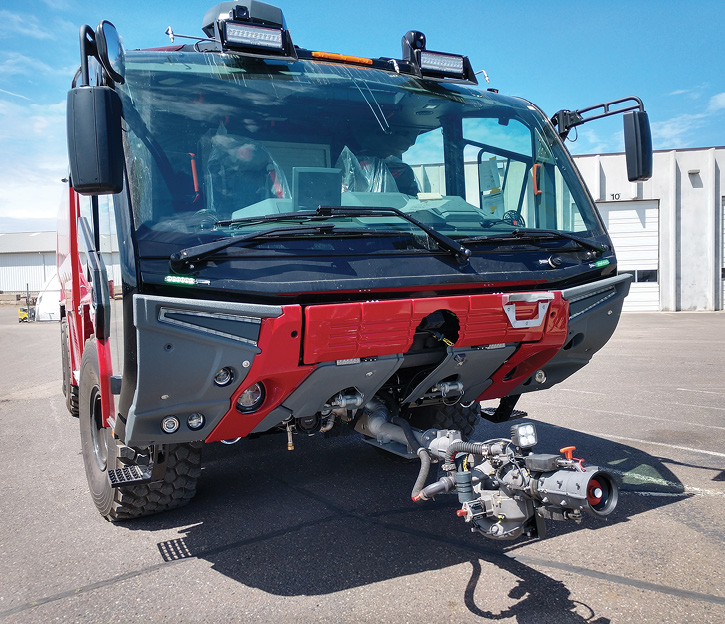
7 Some smaller airports move up to larger size ARFF trucks like this Panther 4×4 built by Rosenbauer for the Portland (ME) International Jetport Airport. Note the RM35 high-volume low-attack (HVLA) bumper turret.
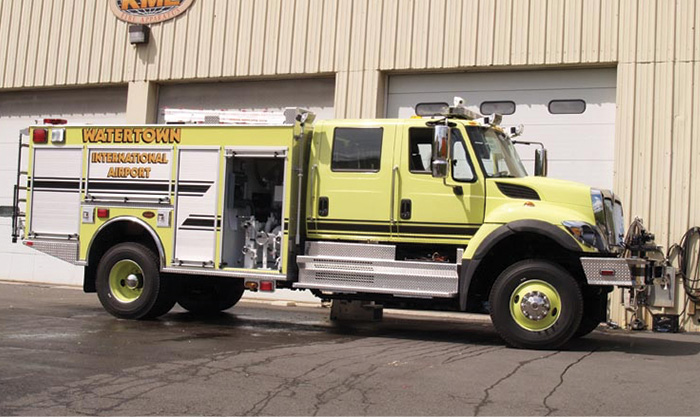
8 KME built this KME FORCE Class 3 RIV on an International chassis for the Watertown (NY) International Airport. (Photos 8-9 courtesy of KME.)
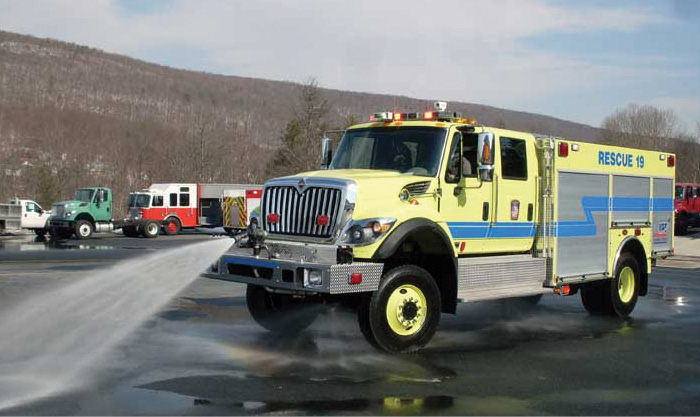
9 The Williamsport (PA) Regional Airport runs this KME FORCE Class 3 ARFF truck, shown here exercising its bumper turret.
Johnson notes that Rosenbauer has seen a lot of interest lately in the Airwolf C2 models as well as vehicles with CAFS capability. “We’ve done a few small ARFF trucks with CAFS, which is fundable on the Airwolf C2 and C3 models through FAA grants,” he says. “A recent one we did was for the Niagara Falls (NY) Airport.” Johnson adds that some of the smaller index airports also opt to purchase a larger Panther 4×4 ARFF truck. “They want the greater capabilities at their fingertips,” he says. “The Panther 4×4 has a Rosenbauer N80 2,100-gpm pump, 1,600-gallon water tank, 200-gallon foam tank, and 500 pounds of dry chemical or 460 pounds of Halotron. It also can carry foam, dry chem, and Halotron, which makes it a triple-agent ARFF truck.”
KME
KME makes three variations of its RIV airport vehicle called KME FORCE™ for Class 1, 2, and 3 airports. The KME FORCE Series Class 1 RIV has a custom aluminum rescue body, 150 gallons of AFFF premix with a CAFS option, and 500 pounds of dry chemical onboard. Matt Reda, international ARFF product manager, says both standard and low-profile units can be produced on a variety of commercial chassis configurations.
The KME FORCE Series Class 2 RIV also has a custom aluminum rescue body and carries 400 gallons of water, 50 gallons of foam, 500 pounds of dry chemical, and a separate engine-driven pump for pump-and-roll capability. The KME FORCE Series Class 3 RIV carries 500 to 700 gallons of water, 60 gallons of foam, 500 pounds of dry chemical, a separate engine-driven pump or a power takeoff pump configuration, and short and long rescue body configurations and is built on a variety of commercial chassis configurations.
GRAND CANYON AIRPORT
The Grand Canyon Airport, located in Grand Canyon Village, Arizona, is an Index B airport, says airport manager Matthew Smith, however it recently retired a 1987 ARFF truck and replaced it with an E-ONE TITAN™ 4×4 ARFF truck with a Hale 8FG 3,000-gpm pump, 1,500-gallon water tank, 325-gallon foam tank, 500-pound dry chemical tank, high-reach extendable turret with a piercing nozzle and forward-looking infrared camera, and bumper turret that produces 75 to 300 gpm. “We also have a Ford F-550 ARFF truck with CAFS, a 500-gallon water tank, 30 gallons of foam, and a bumper turret,” Smith says.
Smith points out that fully staffed the airport has eight firefighters working out of a single station seven miles from the south rim of the Grand Canyon. “We have an 8,999-foot-long, 100-foot-wide runway,” he says, “and can handle Boeing 737 aircraft as well as a lot of military aircraft. We even landed Air Force One in 2015, but a standard day for us would be 19-passenger Beech 1900 twin-engine aircraft, 14-passenger DeHavilland Twin Otters, 12-passenger single-engine Cessna Caravans, and a ton of Bell 206 and Eurostar helicopters.”
ALAN M. PETRILLO is a Tucson, Arizona-based journalist, the author of three novels and five nonfiction books, and a member of the Fire Apparatus & Emergency Equipment Editorial Advisory Board. He served 22 years with the Verdoy (NY) Fire Department, including in the position of chief.

